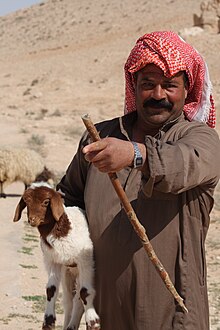Bedouin
The Bedouins are nomadic Arabs who inhabit the deserts of the Near East, the Arabian peninsula (where they originate from) and North Africa, where they spread during the Arab conquests of the seventh century, covering practically all the countries of the Mediterranean coast, from Egypt to Morocco. Today's Bedouins are organized into Badawi-speaking tribes, and consider themselves descendants of the Arab people.
Etymology
The Spanish word «bedouin» comes from the French bédouin, which in turn derives from the Arabic language, bedaui or badawi in colloquial language, which means 'desert dweller'.
History
The Bedouins of the Arabian peninsula, in the time of Muhammad, constituted a social group of about three thousand members; This group was in turn divided into families but united by blood ties, which were transmitted through the mother. The relationship between the different tribes was always difficult and unstable. The characteristics of the Bedouin tribes were, in addition to blood ties, the sense of hospitality, always keeping honor and warrior courage in mind, and appreciation of poetry and eloquence, faculties that served to preserve the &# 34;collective memory" of the Arab people.
These nomadic tribes venerated stones, trees, stars, demons and certain gods or idols that were venerated in Mecca. They were not monotheists. They were very religious. They readily accepted the teachings of Muhammad and became Muslims with more intensity and fervor than the rest of the Arabs.
Very important and definitive in the conquests promoted by Islam was the human contribution of the Bedouins. His strength, aggressiveness, and combat tactics were, to a great extent, effective in allowing Islam to triumph over the great neighboring sedentary empires. The Bedouins carried from generation to generation the memory of their origins, which they mythologized as an idyllic primitive time.
Economy and food
Their economy is based on cattle raising, an activity around which they organize their lives. They constantly move in search of water and pasture. They feed mainly on milk and derivatives, such as a type of butter called ghee. They also eat unleavened wheat bread, round in shape, dates and other fruits that they obtain in the oases of the deserts.
Life and customs
There are three distinct classes of Bedouin: the "true Bedouin" they are nomadic herders and are famous for their caravans crossing the deserts. They are engaged in trade. The fellahin are farmers and have become sedentary; They live on the edge of the desert. A third class of Bedouins has appeared, semi-nomadic, migrating with their animals and also engaged in a stable agriculture.
Their home is low, rectangular tents made from camel or goat hair. They roll up the sides so air can circulate, and when it rains or there are sandstorms, they close tight. One part of the tent is for men and guests, the other is for women and children.
Bedouins wear light clothing to withstand the heat. They wear robes that cover the entire body, except for the face, hands, and feet. The men's dress is called thawb and is made of black cotton. Sometimes they wear silk cloaks or cotton jackets called kibrs, fastened with leather belts.
They are organized by kinship groups. The smallest unit is the family, followed by the clan, and lastly the tribe.
The young children remain in the care of their mothers until they are seven years old, when they already accompany the father in his homework. The women prepare the meals, sew, weave, load the tents, collect firewood and take care of the children and the elderly. It is also said that they are nomadic, another of their characteristics, as seen at the beginning of the Neolithic.
Religion
Most Bedouins are Sunni Muslims. They continue to maintain ancestral beliefs in spirits or geniuses. Some Bedouins have adopted Sufism. Sufis are mystical Muslims who seek to reach a higher degree of consciousness in order to gain a more intimate relationship with God.
Outfit
To withstand the extreme heat of the desert, the Bedouins wear light clothing, tunics that allow air circulation and freedom of movement, providing protection from the sun and sand. Their dresses are designed to cover the entire body except for the face, hands and feet.
The main dress for men is the white cotton thawb or gray tunic. Over the tunic, the men wear long silk cloaks or cotton jackets called kirbs. The jackets are open at the front and have leather snaps.
Since the desert is a hostile environment, clothing works as protection against the sun and sand, at the cost of an increase in body temperature. In any case, when wearing clothes it increases the retention of body fluids (making it difficult for sweat to evaporate, which is retained with the help of the clothes) and when it works as an insulator, interposing itself between the heat of the environment and the body itself. Paradoxically, as night falls in the desert, the temperature drops abruptly, proving that the amount of extra clothing is also a benefit.
On the other hand, white clothing, such as Bedouin tunics, reflects more radiation, and if it works better, in places with such high temperatures. All the people who live in the desert should wear white clothes. The Tuaregs, another desert people, dress in blue (they are known as blue men), so the color seems not to be so important.
Contenido relacionado
Aeschylus
Alexander I (pope)
Persecution of Christians



